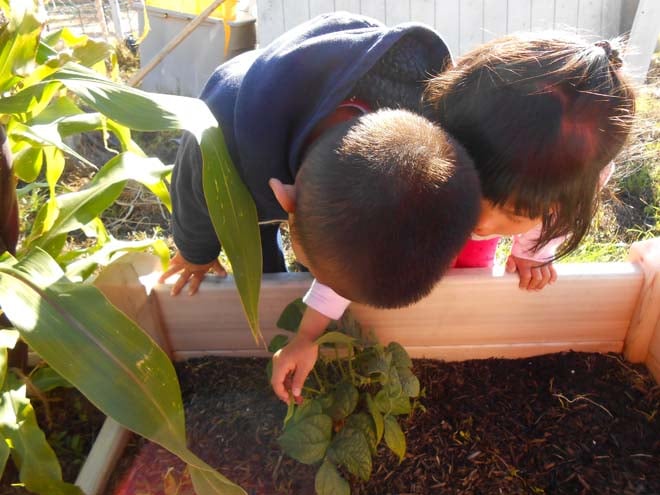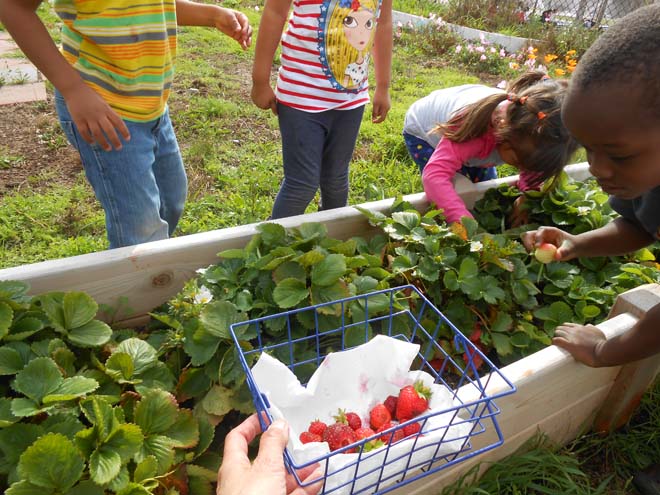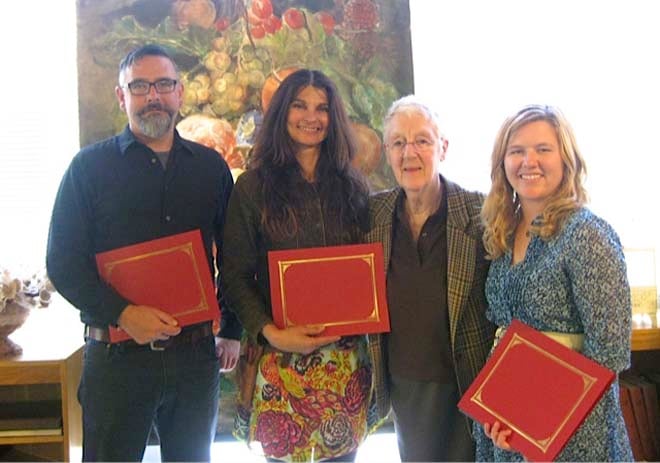
Children Need Gardens

Contributor
Our children no longer learn how to read
the great Book of Nature
from their own direct experience or how to interact creatively
with the seasonal transformation of the planet.
– Wendell Berry

“Teacher Veronica, Teacher Veronica!” A three-year-old child calls me over to a corner of the preschool playground. Small puddles of water dot the yard, the remains of the early morning rain. She points excitedly to her find—an earthworm exposed on the ground—while using her other hand to keep her peers from stomping it dead. An impromptu conversation ensues with the steadily gathering preschoolers of the important relationship earthworms have to soil, plants, and to gardening. Our discussion converts those who wanted it dead into admirers; they are especially impressed with the fact that the head of an earthworm is so unlike theirs.
The discovery of a lone earthworm sparks an invaluable lesson about our interdependence with nature, our differences, this small creature’s important role, and delightfully piques the children’s curiosity. It may be only one moment of many in our day, but the children hold on to it like burgeoning seedlings do their place in a garden lashed about by a heavy, but nourishing rain. They ask about bees, butterflies, and ladybugs—what do they do and eat, where do they live, and why does an earthworm not fly?
We delve into the world of gardening. We look at the seeds of our apples at snack time. The children’s eyes grow wide when they learn that from these seeds grow apple trees. We soak sweet pea seeds—I tell them that the “coat” that each sweet pea seed wears needs to be softened to let the food for the seed out of it’s “coat pockets.” Then we plant the scarified seeds in small clay pots that they have colorfully painted. After placing their newly planted seeds by a sunny window (our preschool is in an urban area of San Francisco with no space for us to garden outside) the children stand looking at their pots with their blank canvases of soil. “When will the seeds grow?” they ask. “They’re growing right now, in the soil,” I reply and continue, “just like you have feet to stand on the ground and need mouths to eat and drink, the seeds are making roots in the ground, so they can stand, eat, and drink, too.” Impatient and doubting whether the seeds will ever really grow, the children listen and sigh, water their pots, then reluctantly go off to play.

A few days later, the familiar shout of “Teacher Veronica!” Smiles abound as the children crowd round the window filled with their clay pots. Small fingers point proudly at their plants. Their clay pots are dotted with minuscule green sprouts pushing their way up through the topsoil. To them it is magic that they have performed helped by water and the sun. They shout and dance happily about. Art centers on themes of flowers, bees, water, earthworms, andsun. In a daily ritual, the children proudly bring their family and visitors over to the window to see the progress of their sweet peas before they leave to go home.
Yes, the children are learning self-regulation by modulating their impatience and learning to respect a rhythm that beats to a much slower time than theirs. Yes, they relish the responsibility of watering their sweet peas, so much so that I have to make a chart and assign them each a day to subdue shouts of “My turn!” “No, it’s my turn!” Yes, the children are so very proud of what they have nurtured, of what they have helped grow. They constantly measure growth, inspect the winding stems, touch the emerald green leaves, gasp at the first buds, and recite the colors of the blooms.
But I want more—so much more for them.
I want the children to be outside in a garden with the sun, the wind, trees, flowers, and vegetables, digging, planting, watering and using tools. I want their gardening experience to be a whole body experience—which is how children learn best—where all of their senses are activated and stimulated.
I want for them a garden where they can breath fresh air, touch and smell flowers, dream, hide, and marvel as they watch a butterfly flutter past, a ladybug crawl on a leaf, hear the hum of bees, find earthworms in the soil. Where working together means the seeds and starts they have planted, watered, weeded, and cared for—kale, lettuce, radishes, and carrots—grow into nourishing food they can eat and share.
Developing self-efficacy, self-confidence, community, understanding the cycle of life, observing, imagining, laughter and fun—a garden gives children the opportunity for all of this to occur.
Children need gardens.
For most of us the fast pace of the twenty-first century means over-scheduled lives, a dearth of time to spend outside, face-to-face communication replaced by a binary code, a loss of connection to who we are, and what really matters. Testing in schools trumps recess and play.
Children need gardens to connect to each other, to their food, and to themselves. They need a place of refuge, a place to slow down, to have hands-on experiences that enable them to learn how to read “the Great Book of Nature.”
Nature, plants, our food. How can you appreciate, participate, and take care of something if you do not have a relationship with it? If you have no access to it? Who, then, will be the future stewards of nature and our gardens?
Barbara Pitschel, and her husband Roland understood the importance and necessity of advocating for nature and gardening. Because of their hard work and dedication Bernal Heights Park will never be developed and will remain preserved for future generations to enjoy and appreciate. It will be a place where children can learn how to read the Great Book of Nature.
Children need gardens, but gardens need children, too.

Veronica Voss-Macomber is this year’s Pitschel Prize recipient for the above essay entitled “Children Need Gardens.” Nicole Davis and Zann Cannon Goff placed second and third respectively. Now in its second year the Pitschel Prize was created to commemorate the life and work of Barbara Pitschel, lontime head librarian of the Helen Crocker Russell Library at San Francisco Botanical Garden, and is supported by the San Fancisco Botanical Garden Society and the San Francisco Garden Club.










Responses